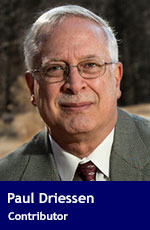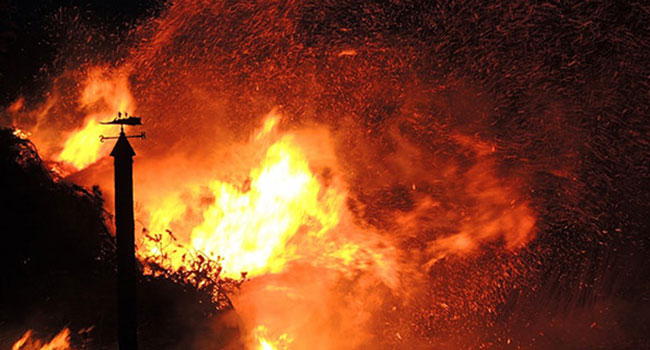 In what has become an annual summer tragedy, wildfires again destroyed western U.S. forests this year.
In what has become an annual summer tragedy, wildfires again destroyed western U.S. forests this year.
Millions of acres and millions of animals have been incinerated, hundreds of homes reduced to ash and rubble, dozens of parents and children killed, and many more people left missing, injured or burned.
Air quality across wide regions and entire states was so bad people were told to stay indoors, where many hibernated for months because of COVID-19, but indoor air was also contaminated. Acrid smoke and soot was carried far and wide.
Firefighters were profiles in courage as they battled the blazes for days on end, while all too many politicians displayed profiles in opportunism.
“If you give a climate arsonist four more years in the White House, why would anyone be surprised if more of America is ablaze?” Democratic presidential candidate Joe Biden thundered on the campaign trail.
“Mother Earth is angry,” U.S. House speaker Nancy Pelosi pontificated. “She’s telling us with hurricanes on the Gulf Coast, fires in the West, that the climate crisis is real.”
Despite finally starting to thin out overgrown forests, California Gov. Gavin Newsom resorted to the longstanding party line about his state’s wildfires: Manmade “climate change is real. If you don’t believe in science, come to California and observe it with your own eyes.”
Washington Gov. Jay Inslee agreed. “These are climate fires,” he said. “And we cannot, and we will not, surrender our state and expose people to have their homes burned down and their lives lost because of climate fires.”
It’s ideological nonsense, intended to deflect blame and avoid responsibility for decades of public policy errors and forest mismanagement – and to justify new laws that would multiply government control over energy, industries, jobs, living standards, lives, property, and freedom to choose where and how we live.
One could argue that people shouldn’t have built homes in and near these forests. That they should have been persuaded or compelled to live in crowded urban areas, where crime, riots and COVID-19 run rampant. But they do live in rural areas – and politicians, land managers and judges have a duty to implement policies and practices that protect their homes, communities and lives, as well wildlife.
Perhaps slightly warmer or drier summers have made the wildfires slightly more likely or frequent. But decades of laws, lawsuits, fire suppression policies and forest mismanagement practices have guaranteed the buildup of massive amounts of dead and diseased trees, dry brush and grass, and decaying leaves, needles and debris. With every wet spring spurring plant growth that dries up every dry summer, just one lightning strike, careless camper, gender-revealing pyrotechnic or angry arsonist can ignite an inferno.
Because timber harvesting and thinning have been banned for decades, thousands of scrawny trees grow on acreage that should have just a few hundred full-sized mature trees. As of 2017, tens of billions of scrawny trees mix with 6.3 billion dead trees in 11 Western states; state and federal forests in California alone had over 129 million dead trees. Those numbers have most assuredly skyrocketed since 2017, while steadily increasing dry brush and debris now provide even more tinder for superheated conflagrations.
Flames in average fires along the ground in managed forests might reach a few metres in height and temperatures of 800C, says Wildfire Today. But under conditions now found in western tinderboxes, flame heights can reach 50 metres or more, and crown fires can generate critter-roasting, soil-baking temperatures that exceed 1,200C.
Most of this hellish heat goes upward, but super-high temperatures incinerate endangered wildlife – as well as organisms and organic matter in thin soils that for decades afterward can support only weeds, grass and stunted, spindly trees. Western conflagrations jump fire breaks because these ferocious fires are fueled by the unprecedented increase in combustibles that radical environmentalist policies have created.
These monstrous fires generate their own high winds and even mini tornados that carry burning branches high into the air, to be deposited a hundred metres away, igniting new fires.
None of this has a thing to do with climate change. To say a 0.1, 0.5 or even 1.0C degree change in average global temperatures would alter these forest fire dynamics defies credibility.
To say the monumental fuel buildups in our forests are irrelevant is like claiming a minimally furnished home will burn as easily and ferociously as one filled to the brim with furniture, books, old newspapers and cans of gasoline.
The solution is simple, though expensive and time-consuming. Cut the red tape. Remove some of that fuel so fires don’t get so big, hot, powerful and destructive. Clear wider areas around buildings, homes and communities. Create more, wider fire breaks. Build more roads that let people escape the flames.
Send the timber to sawmills, to create jobs and tax revenues, and lumber for affordable homes. Clear out brush and grass under transmission lines – and upgrade the transmission lines. Bolster rapid-response airborne and ground-based firefighting capabilities.
All this has been prohibited, litigated and shut down in states that now suffer from horrific fires. Radical greens have even blocked cattle grazing that would control grass and brush in national forests.
Still not convinced?
Look at recent major fires that petered out when they reached managed forests.
For years, San Carlos Apache Indian Reservation foresters chain-sawed overgrown trees, harvested better timber, improved timber stands, and used controlled, prescribed burns, weed killer and other measures to keep their forests healthy, protect sacred sites, and preserve jobs and wildlife. They even turn scrubby trash trees into particle boards and sell them for furniture, as part of the tribe’s timber business.
In 2017, the Wallow Fire, the most destructive wildfire in Arizona history, burned 538,000 acres – but fizzled out when it reached the reservation’s well-managed forest.
A year later, the Rattlesnake Fire torched more than 20,000 acres in the Apache-Sitgreaves National Forest – but likewise faded out when it reached the neighboring White Mountain Apache timberlands. Those lands had also been managed responsibly and proactively, using the same management practices that guide San Carlos Apache foresters.
Similar success stories can be found in the most unlikely place: California. For decades, the Southern California Edison electric utility employed selective logging, prescribed burns and other management strategies in its Shaver Lake Forest. This year’s Creek Fire raged through treetops and several hundred thousand acres in the Sierra National Forest. But when it reached the Southern California Edison timberlands, it dwindled into a low-intensity surface or ground fire – which doesn’t incinerate big trees and wildlife.
In August 2013, the monstrous high-intensity Rim Fire immolated 180,000 acres in the Stanislaus National Forest. Thankfully the National Park Service had been employing prescribed burning and other proactive management practices for years in Yosemite National Park next door. When the wildfire reached the park, it turned into a far less destructive surface fire.
The ferocious Rough Fire of 2015 roared through California’s Sequoia and Sierra National Forests, totally torching 150,000 acres. But it too became a ground fire when it reached Sequoia National Park, where the National Park Service had also used prescribed burns and other good management practices for decades.
The raging fires in long mismanaged American forests are not natural. They’re not what used to burn with regularity through forests. A century of fire suppression and fuel accumulation means they turn into superheated infernos.
Manage them properly first. Then let nature work again.
Regardless of what Earth’s climate may do – regardless of who or what may be responsible for any fluctuations – we must take responsible, appropriate, effective measures now. Doing so will save habitats, wildlife, homes and human lives today, and tomorrow.
We cannot and must not let more megafires incinerate forests and people for decades to come, under an hubristic, misguided, ideological belief that we can eventually end global fossil fuel use and control planetary climate and weather conditions, thereby somehow making monster wildfires a dim memory.
Paul Driessen is senior policy analyst for the Committee For A Constructive Tomorrow (www.CFACT.org) and author of books and articles on energy, environment, climate and human rights issues. This column was supplied by the Frontier Centre for Public Policy.
Paul is a Troy Media Thought Leader. Why aren’t you?
For interview requests, click here. You must be a Troy Media Marketplace media subscriber to access our Sourcebook.
The views, opinions and positions expressed by columnists and contributors are the author’s alone. They do not inherently or expressly reflect the views, opinions and/or positions of our publication.

